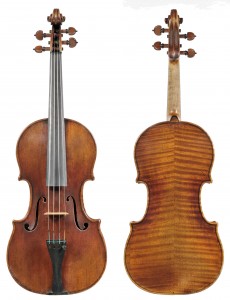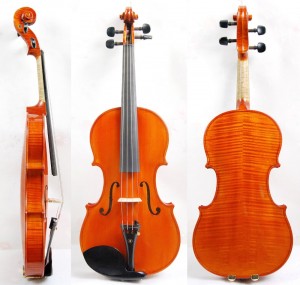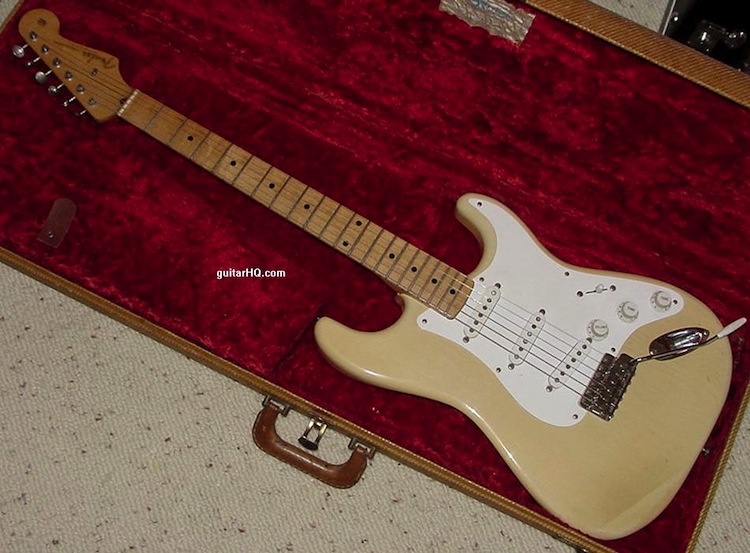A well-preserved Stradivarius violin was sold in an online auction for a record £9.8m.
What is it about the violins made by Italian craftsman Stradivari that makes the instruments so valuable?
Over the years, various theories have been touted in a bid to find out why a Stradivarius produces such brilliant sound quality. Antonio Stradivari is considered to be the most distinguished craftsman of the instrument.
Born in 1644, he established his workshop in Cremona, Italy, and remained there until his death in 1737. He made over 1,000 violins, violas and violoncellos, and was commissioned by King James II of England and King Charles III of Spain.
It is believed that around 650 of these instruments have survived. His best violins and instruments were made during what is considered his golden period from 1700-1725.
His most famous violins include the 1715 Lipinski and the 1716 Messiah. There is still considerable debate about why the violins made by Stradivari sound superior to modern-day instruments.
In 2003, scientists from Columbia and Tennessee universities in the US claimed reduced solar activity in the 17th Century may be the reason for the Stradivarius sound.
They said the colder winters and cooler summers at the time produced slower tree growth which in turn led to denser wood with superior acoustical properties – circumstances not repeated since.
In 2006, other US researchers said they believed a Stradivarius owed its distinct sound to a chemical treatment designed to kill woodworm and fungi. It was once argued that Stradivari and others used wood from ancient churches, or that they added a mysterious ingredient to the wood, or used techniques that have since been lost.
Some have focused on the type of varnish used on the instruments. Many of today’s violin-makers have been unimpressed by such theories, putting the quality down to pure genius on Stradivari’s part.
The Cambridge Companion to the Violin states that the structure of a Stradivarius is key, noting the flatter shape and the shape of the plates (the panels that make up the front and back of the violin). Ariane Todes, editor of The Strad magazine, concurs.
“They don’t all sound fantastic but a good one that’s been set up properly – the thickening of the wooden plate, the movement of the sound post and bass bar – sounds fantastic,” she says. Dr Jon Whiteley, a curator at the Ashmolean Museum in Oxford, which houses the famous Messiah Stradivarius agrees the quality “depends heavily on the shape of the instrument.”
He explains that Stradivari’s challenge was to produce both expressive sound and the volume needed for large concert halls. Prior to the period when Stradivari was honing his craft, violin performances were usually confined to small venues such as private parties and were often used in quartets for chamber music, which did not require a huge sound.
“Stradivari came through, he proved a match for the new music being made,” says Dr Whiteley.
“All his life he was searching for the ideal shape.”
According to Dr Whiteley, Stradivari experimented with various forms, including a longer model. By the early 18th Century, he had produced a violin that was “not as long but quite large, flatter but not so flat that you lose the resonance that makes the violin so magical”.
Stradivari’s instruments were “exquisitely crafted, the pinnacle of sound engineering”.
The quality of a Stradivarius is “down to someone who was always trying to do better, he was always getting feedback from players, there was constant self-criticism”.
However, Dr Whiteley points out that the shape of the soundbox is not as important as the talent of the violinist.
“A great violinist like Yehudi Menuhin could make a great sound from an old box and a piece of wire.”
So how does a musician who plays a Strad feel about it?
Paul Barritt is the permanent guest leader with the Halle Orchestra based in Manchester.
‘Work of art’ He uses a Stradivarius which has been on loan to the Halle for the last seven or eight years.
Barritt is keen to point out that there are “other wonderful makes like the Guarneri”. But he says the Strad is so special because of the clarity of tone.
“In a big concert hall, I know the tone will carry. It’s not just how loud it is, it’s the clarity.
“Each Strad is a character of its own, each has a very strong personality that makes them something to deal with, rather like an old house that is very interesting but doesn’t always do exactly what you want,” he explains.
“You have to go with the character of the instrument and then you will get great rewards.”
He also remarks on Stradivari’s impressive skill.
“Stradivari was a great workman. The cutting of the inlay is incredible and the beauty is extraordinary,” he says.
Todes says there is another major reason why we should cherish the Stradivarius.
“If you compare it to an old Italian painting, the Strad is an incredible historical artefact that needs to be preserved. It’s a work of art
What is so special about Stradivarius Violin?
 People wonder why the violins that have been created by the famous Italian craftsman Stradivari have become so valuable. Antonio Stradivari is considered to be the genius behind the creation of this extraordinary instrument and over the last several decades, people have argued over and over again regarding what makes the Stradivarius violin outstanding from the other kinds of available violins as its sound quality surpasses brilliance.
People wonder why the violins that have been created by the famous Italian craftsman Stradivari have become so valuable. Antonio Stradivari is considered to be the genius behind the creation of this extraordinary instrument and over the last several decades, people have argued over and over again regarding what makes the Stradivarius violin outstanding from the other kinds of available violins as its sound quality surpasses brilliance.
In order to learn more about the Stradivarius violins, it is important to take a sneak peek on the creator of the wonderful instrument. Stradivari made over a 1000 violins in his lifetime and had the privilege of being commissioned by the King James II of England and King Charles III of Spain. Out of the 1000 violins that he had created, around 650 have survived and are available in the modern world. It has been believed that some of the best instruments that have been created from him were in the era of 1700-1725. His extraordinary and popular violins definitely include the 1715 Lipinski and the 1716 Messiah.
However, the debate still continues regarding the superior quality of sound produced from the Stradivarius violins when compared to the other kind of modern day equipments. Several researches and studies were carried on this direction and in the year of 2003, a group of scientists from the universities in Tennessee and Columbia came to the conclusion that it could be the result of the reduced solar activity in the 17th century that such high quality sound and music is produced from the Stradivarius violins. The researchers argued that the occurrence of the cooler summers and colder winters gave rise to the slower growth in trees and thus denser wood with high quality of acoustical properties was produced.
Another group of researchers reached the conclusion in 2006 that the distinct and unique sound produced from a Stradivarius violin is a result of the chemical treatment that the wood undergoes in order to get rid of fungi and woodworms.
One of the main differences that has been observed between a Stradivarius violin and an Amati is that the former produces a very straight and strong ‘C’ bout and the f-holes in the Stradivarius violin seems to be more straighter and longer than the Amati. The choice of varnish which is the strong shade of red pigment that has been used in Stradivarius violins definitely seems to be a very innovative idea that has been used in the creation of these unique instruments. Experts believe that the wrong kind of varnishing can definitely hamper the vibrational quality of the wood.
Last but not the least; nobody can argue that the Stradivarius violins are definitely a mesmerizing work of art which stands out from the rest of the violin creations that has been available throughout the world.
Strad or Dud?
Is my violin a real Stradivarius? Discovering “The Red Violin” of Stradivariuses is pretty much impossible.
Several times a day I receive a call or email from someone, like the hundreds of people before him, who found a Stradivarius violin!
Or could it be?
Antonio Stradivari was a violin, viola, cello, harp and guitar maker in Cremona, Italy. He was born in 1644 and died in 1737 and made over 1,100 instruments during his lifetime. He is renowned for his superb violins and his “violin formula” has become the ideal design model for violin makers for more than 250 years.
Famous violinists such as Itzak Perlman, Joshua Bell and Issac Stern play on Stradivarius violins which are loaned to them by rich benefactors or museum societies.
Stradivarius violins have sold on auction for millions of dollars. You can see why people get a bit excited about unearthing such a promising treasure, especially when the label says “Antonius Stradivarius Cremonensis Faciebat Anno 1720.” It seems authentic enough, right?
Wrong!
All 650 of the surviving Stradivarius instruments have been accounted for. Discovering “The Red Violin” of Stradivariuses is pretty much impossible.
How do so many people discover Stradivariuses in the attic if they are all accounted for?
Hundreds of thousands of violins have been made which copy the Stradivarius design and bear labels that read “Stradivarius.”
This practice once was a kind tribute to Stradivari and his remarkable craftsmanship as well as a way of specifying the model around which an instrument was designed.
Recently, however, the confusion generated by the false labels has led to commercial gain for scheming crooks. A sly seller can deceive an inexperienced buyer with a battered old fiddle with a label and phony certificate of authenticity. Many collectors have paid large sums of money for fake Strads. (Talk about bad investments; forget depreciating houses and crashing stocks when you can buy dud Strads for hundreds of thousands of dollars).
Most buyers today consult an appraiser to avoid being swindled. Other times an appraiser isn’t necessary since it is obvious the violin is a fake. One of my violins has the usual Strad label and date, followed by “Made in Germany.” Identification such as that was required by United States regulations on imported goods in the late 1800s.
It’s not a real Strad!
The Smithsonian Institution states that “a violin’s authenticity can only be determined through comparative study of design, model, wood characteristics, and varnish texture.” In short, many hours of tests and comparisons by an experienced luthier (violin maker) who has seen hundreds of genuine and replica Stradivariuses can tell the difference.
Don’t throw that violin in the woodpile just yet! There is still hope for your fiddle’s greatness. It may be a copy, but it could be a really good copy. In fact, in 1851 Joseph Rocca made a convincing copy of the world’s finest violin, the “Messiah” Strad, and had the experts duped until only recently. Any violinist would be only too happy to settle for a copy that sounds as good as that one.
Really, cost and label aside, a violin is an instrument, a tool for making music. Who cares if your fiddle was made by a Norwegian goat herder or a factory assembler in China? What matters most is how it sounds when you draw your bow across its strings.
So get that poor old beauty out of its case, fix it up and learn to make it sing again. If you can’t, then give it to someone who can make it sing, donate it to a non-profit group who helps disadvantaged kids play, or trade it towards a finer instrument (enter shameless plug for my violin shop).
Music created by the heart is far more valuable to our souls than a Stradivarius ever could be.
Credits:
Article by the BBC
www.stradivarius.com
http://www.lessonscity.com/










